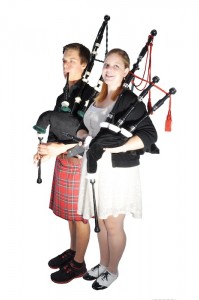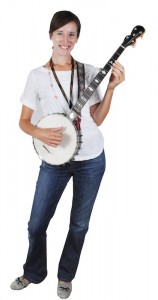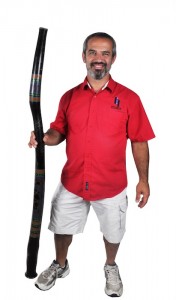
David Olderman, Accordion
One hundred-twenty buttons, 40 keys, one instrument. David Olderman, social studies teacher, has made it his goal to become an accordionist that knows the instrument inside and out.
“I love the sound of the instrument,” Olderman said. “It just resonates with me.”
Olderman’s admiration for the instrument stemmed from his childhood. Having grown up in Cleveland, OH, Olderman was frequently exposed to the instrument because of the town’s large European and Polish background.
“I can remember the first time I heard [the accordion],” Olderman said. “I was watching a TV show called Polka Varieties, and thought it was just a really cool instrument.”
Although he is, as he puts it, “one of the few” to play the instrument, Olderman claims he is not a very advanced player.
“It has been three years, and I’m still on the beginner book,” Olderman said. “I’m not a prodigy. I tell my students that the accordion takes a lot of coordination, and I’m just not that coordinated, but I am enjoying it. I am trying to learn the instrument and have fun at the same time.”
Despite his self-claimed lack of skill, Olderman will continue to pursue his passion for accordion playing.
“It would be fun to be in a band, but right now I intend to keep up, get better and develop my own repertoire, maybe even learn the Kirkwood fight song,” Olderman said. “I just want to be kind of a journeyman musician.”

Marissa Myers, Ocarina
The sweet potato ocarina has never been a staple for music of any genre. A novelty in the musical world, the instrument was popularized by Nintendo’s The Legend of Zelda: Ocarina of Time, and made many players of the game, such as Marissa Myers, junior, want to learn how to play it.
“My parents bought [my brother] and me The Legend of Zelda game, and it had a connection where we could play together,” Myers said. “We played all the time, it was our favorite game, and he was the reason I wanted to get [an ocarina]. He kind of strove me to get it because it was a piece of something we played with so often together.”
The Ocarina produces a sound similar to a flute and is the basis of progression through the game. Myers said the Ocarina is a wind instrument played with two hands and comes in several varieties ranging from four to 24 holes, with price generally increasing with the range of the instrument.
Myers does not play her ocarina in any groups but said she occasionally plays for friends and family.
“I don’t play it every single day for multiple hours, but I do put in quite a bit of hard work,” Myers said. “I feel very proud to play it because it is something nobody had really heard and I can do something unique for them that is special.”
Myers spent 40 dollars on her instrument and considers it money well spent.
“[The ocarina] is one of my most prized possessions,” Myers said. “I spent two weeks saving up my allowance to my buy it. I wouldn’t give it away for anything.”

Andrew Hopkins and Sophia Matthews, Bagpipes
Although Kirkwood born and raised, Sophia Matthews, senior, plays an instrument that connects her to the land of kilts, rolling green hills and haggas.
“I started playing because of a family joke,” Matthews said. “My grandmother always said she wanted me to play bagpipes at her funeral, so I took it seriously and started to learn the instrument. Granted, she just ran her first marathon at age 72, so I have some time.”
Since the summer before her junior year, Matthews has been taking lessons to master the instrument. After several years of practice, Matthews wants to make an appearance with her pipes.
“I hope Andrew Hopkins and I can at least play the bagpipes at a couple of away games this year with the marching band,” Matthews said. “It was actually kind of funny, we both took lessons but didn’t find out we both played the pipes until this summer.”
Like Matthews, Hopkins, sophomore, started playing bagpipes because of his family.
“My great grandfather played [the bagpipes], my grandfather played, and he introduced them to me,” Hopkins said. “I just got hooked on them.”
Matthews said that along with liking the sound of the instrument, it also helps establish individuality.
“Besides my grandma, another reason I wanted to play was because I realized ‘hey, this is a way to stand out’,” Matthews said. “I play the flute, which is a very common instrument, and in order to stand out or get recognition on it, you have to be really good. It’s easy to stand out when you have three big drones sticking out of your instrument.”
Hopkins agreed that bagpipes players are considered more unique.
“They definitely make whoever is playing them stick out in a crowd, as if wearing a kilt isn’t enough,” Hopkins said. “But the unique music and the look of awe that the audience gets makes everything worth it.”
With two pipers at KHS, a bit of rivalry has developed.
“Hopkins is better than me musically, and I think I’m better technically,” Matthews said. “I give him crap, tell him he stole my thunder, but I’m glad he plays.”

David Edwards, Mandolin
As a trombonist in the marching band and an upright bass player during concert band season, David Edwards, junior, also plays one of the string family’s more unusual members.
“Only my closest friends really know that I play the mandolin,” Edwards said. “I don’t play it in any bands. I just pick it up and mess around with it when I’m bored.”
Edwards started playing the instrument because of one of his musician friends, Jess Grommet, a 2012 KHS graduate currently studying guitar performance at Belmont University.
“My friend Jess had a mandolin, and I’d pick it up and play a few chords whenever I went over to his house,” Edwards said. “Eventually I bought myself an acoustic on Amazon for $50 so I didn’t always have to go to his house to play.”
The mandolin, however, was already an instrument Edwards was familiar with before he started playing.
“I listened to a lot of bluegrass [and folk] music, with some of my favorite bands being Punch Brothers and Mumford and Sons,” Edwards said. “I actually have a favorite mandolinist, and he’s the lead musician for Punch Brothers.”
Despite his interest in music that uses the mandolin, Edwards said he does not plan on pursuing the instrument.
“Mandolin is fun to play, but I focus a lot more on the bass,” Edwards said. “Bass is the instrument I prefer to play more and hope to go farther with.”
Edwards offered the following to aspiring mandolinists.
“If you are thinking about playing [the mandolin], all I have to say is go for it,” Edwards said. “It’s really fun to play and easy to pick up and start learning. It has an amazing sound, but not many people know about it because it is really only used in bluegrass, but it deserves a lot more credit than it gets.”

Emily Berty, Banjo
The instrument made famous for its appearance in the film Deliverance also serves as the musical outlet for Emily Berty, college counselor.
“I think [the banjo] is awesome,” Berty said. “It has such a rich history and American lineage. There’s more to it than just the creepy Deliverance song, which is the only thing people ask me to play when they find out.”
With increasing appearances in modern music with bands such as Mumford and Sons and The Avett Brothers, Berty said she has always admired the banjo, but did not think of learning the instrument until she saw it played in a live setting.
“I saw a band called The Head and the Heart in concert during summer of 2011, and they had a banjo player named Abigail Washburn. I can just remember thinking ‘I want to be like her when I grow up,’” Berty said. “That was when I decided I wanted to play.”
Berty said despite having played the French horn in middle school, she does not have a musical background.
“I am still very much a novice,” Berty said. “I have enough of an ear to tell when something is not right, but not always good enough to know exactly what it is.”
In order to develop her skills, Berty takes lessons from a teacher once a month, and said she invested several hundred dollars in pursuing the banjo.
“My teacher tells me I’m good, but I’d like to play in collaboration with other musicians,” Berty said. “I would enjoy being in a band at some point.”
Berty said although the instrument is commonly associated with bluegrass, it is not her main genre, and said the instrument was surprisingly versatile.
“I decided to pick up the most obscure instrument I could hear in modern music, but to anybody thinking about learning [the banjo], do it,” Berty said. “A lot of people have told me it is difficult, but the biggest thing is just making it happen. Just pick it up and have fun with it.”

Bob Becker, Didgeridoo
Even though Bob Becker, chemistry teacher, claims to use a trombone-like sound tube in a class demonstration, he chides himself on his personal understanding of music.
“I’m not very musically inclined,” Becker said. “Actually, I’m pretty much tone-deaf.”
Approximately fifteen years ago at the annual arts fair in Laumeier Sculpture Park, Becker first saw the didgeridoo, a cylindrical wind instrument developed by aboriginal Australians.
“There was this guy [at the fair] walking around playing his didgeridoo and selling them, and I just noticed how cool they were,” Becker said. “They were like sculptures, they were beautifully painted, and [the player] made it look so easy. So I got one.”
Becker failed to foresee the challenge the didgeridoo presented him in circular breathing, a technique used to garner the relatively massive amount of air required to play the instrument.
“You breathe into your nose while breathing out of your mouth nonstop, and eventually you get some cool sounds out of it, but it is quite a challenge,” Becker said.
It is this challenge that has prohibited Becker from mastering the tones of the didgeridoo since purchasing his and neglecting to play for an audience. Becker does, however, have somewhat of an aspiration to resume his studies of the didgeridoo in the future.
“I think when I retire [learning to play the didgeridoo] will be on my bucket list,” Becker said. “But I don’t ever see myself being an international competitor in didgeridoo playing.”












